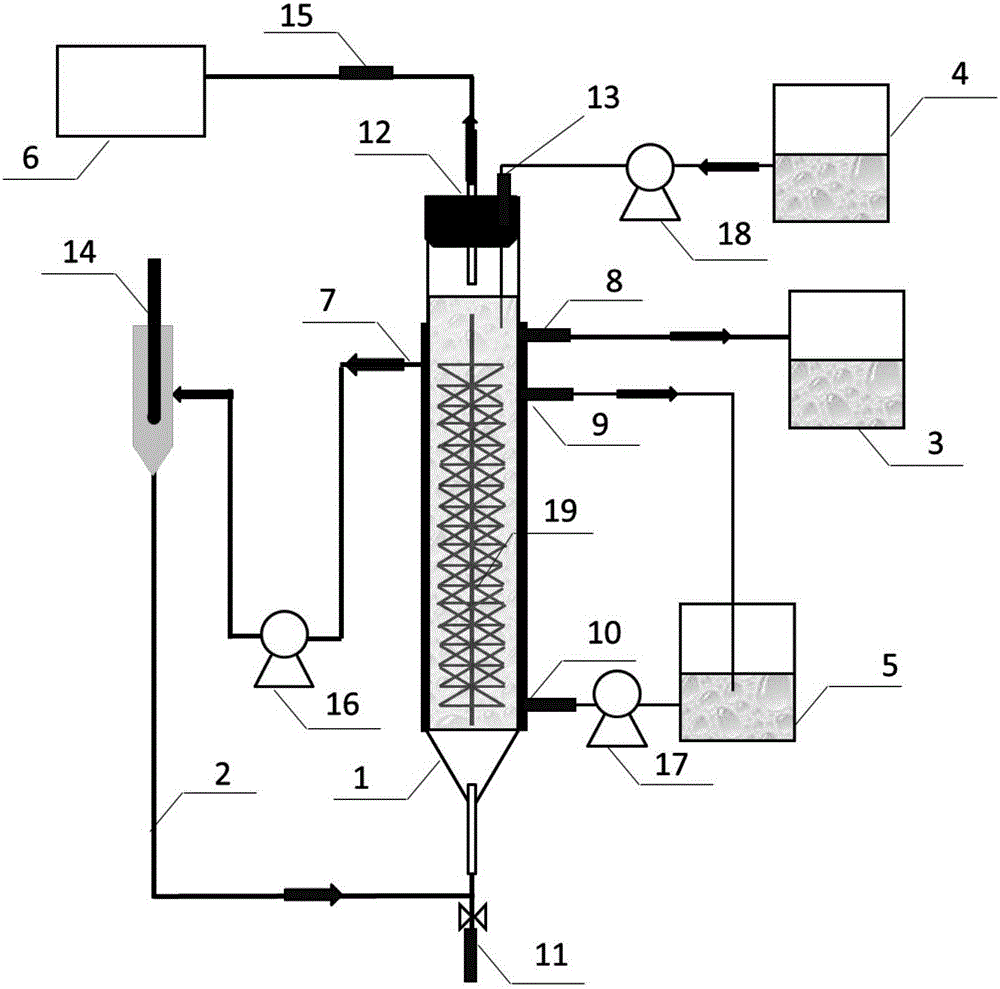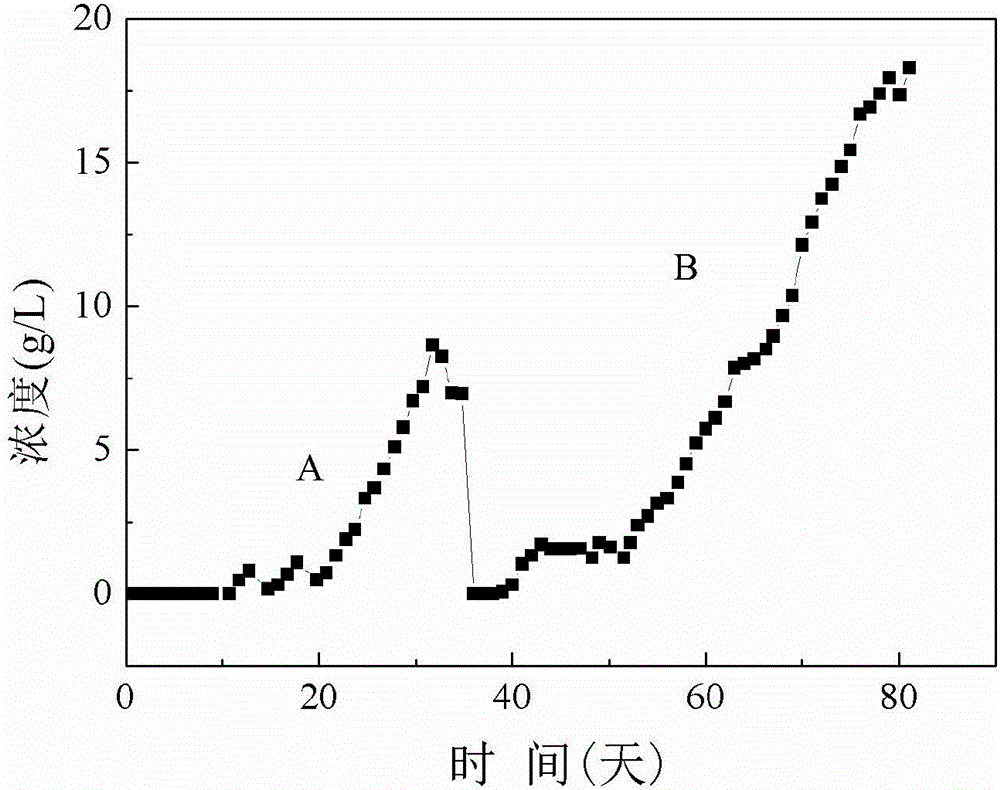Method for producing propionic acid by mixed bacteria system fermentation
A system, propionic acid technology, applied in the field of microorganisms, can solve the problems of inability to meet the needs of industrialization, high input-output ratio, low industrial value, etc., and achieve the effect of facilitating the implementation of industrialization and low input-output
- Summary
- Abstract
- Description
- Claims
- Application Information
AI Technical Summary
Problems solved by technology
Method used
Image
Examples
Embodiment 1
[0042] Embodiment 1: fermentation method (first round of fermentation) of the present invention
[0043] The medium composition that this embodiment adopts is:
[0044] NH 4 Cl, 530mg / L; KH 2 PO 4 2H 2 O, 200mg / L; Na 2 SO 4 , 40mg / L; KCl, 50mg / L; CaCl 2 , 10mg / L; MgCl 2 ·6H 2 O, 70mg / L; MnCl 2 4H 2 O, 0.8mg / L; CoCl 2 2H 2 O, 1.2mg / L; FeSO 4 ·7H 2 O, 3.2mg / L; AlCl 3 , 0.5mg / L; NaMO 4 2H 2 O, 1 mg / L; H 3 BO 3 , 0.2mg / L; NiCl 2 ·6H 2 O, 0.5mg / L; CuCl 2 2H 2 O, 1.1mg / L; ZnSO 4 2H 2 O, 3.2mg / L; EDTA (Na + type), 3.0mg / L.
[0045] The composition of present embodiment anaerobic sludge flora:
[0046] Methanosaeta 8%,Methanobacterium 0.4%,Dethiosulfovibrionaceae9.1%,Anaerolinaceae 7.1%,Streptococcaceae 6.9%,Syntrophobacteraceae 4.2%,Cloacamonaceae 3.7%,Syntrophorhabdaceae 3.5%,SB-1 3.4%,Geobacteraceae3.1%,Clostridiaceae 2.5%,Porphyromonadaceae 1.9 %,Pseudomonadaceae 1.7%,Syntrophomonadaceae 1.6%,[Tissierellaceae]1.5%,Syntrophaceae 1.5%,Synergistaceae 1.3%,...
Embodiment 2
[0056] Embodiment 2: fermentation method (second round of fermentation) of the present invention
[0057] The solid matter containing flora and the anaerobic fermentation medium (same as Example 1) in Example 1 are used to form a fermentation system, the pH value of the fermentation system is adjusted to be between 7.0-7.3, and the temperature is between 35-37°C. Add 5g glycerol to the fermentation system to make the concentration of organic matter between 0.1-5g / L, gradually increase the concentration of ammonium ions in the fermentation system according to the promotion rate of 0.3g / (L d), until the concentration of ammonium ions in the fermentation system is 1g / L L, the process time is generally 7-20 days.
[0058] After the ammonium ion concentration in the fermentation system is stabilized at 1g / L, keep the ion concentration constant, and continue to add organic glycerol to the reaction system in the sequential batch mode to maintain the organic concentration between 0.1-...
Embodiment 3
[0062] Embodiment 3: fermentation method of the present invention (first round+second round of fermentation)
[0063] According to the method of embodiment 1 and embodiment 2, with being different from the anaerobic sludge in the anaerobic fermentation tank of another sewage treatment plant of embodiment 1 as starting material, flora composition is as follows:
[0064] Methanosaeta 10%,Methanobacterium 2.5%,Anaerolinaceae 15.5%,Streptococcaceae 12.8%,Cloacamonaceae 6.5%,Thermotogaceae 6.2%,Dethiosulfovibrionaceae 4.2%,Ruminococcaceae 3.6%,Enterobacteriaceae 2.7%,Clostridiaceae 2.5%,Peptococcaceae 2.3%,Syntrophomonadaceae 1.9%,Porphyromonadaceae 1.7 %, Geobacteraceae 1.7%, Gracilibacteraceae 1.6%, Synergistaceae 0.9%, Pseudomonadaceae 0.6%, Sphaerochaetaceae 0.5%, other 22.3% (content less than 0.5% and unclassified flora not listed).
[0065] After the first round of fermentation, it was detected that the purity of propionic acid was 96%, the concentration was 7.6g / L, the meth...
PUM
 Login to View More
Login to View More Abstract
Description
Claims
Application Information
 Login to View More
Login to View More - R&D
- Intellectual Property
- Life Sciences
- Materials
- Tech Scout
- Unparalleled Data Quality
- Higher Quality Content
- 60% Fewer Hallucinations
Browse by: Latest US Patents, China's latest patents, Technical Efficacy Thesaurus, Application Domain, Technology Topic, Popular Technical Reports.
© 2025 PatSnap. All rights reserved.Legal|Privacy policy|Modern Slavery Act Transparency Statement|Sitemap|About US| Contact US: help@patsnap.com


